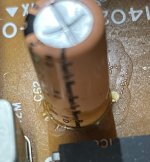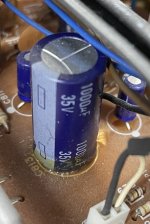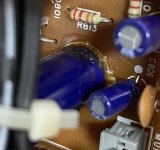Have a NAD 7240pe with scratchy dropouts in the right channel preamp section. I’ve done the deoxit and cleaning to no avail. Thinking maybe it’s some caps, but never replaced them before. There are 3 caps in the preamp section that have some dried liquid around the base but I don’t know if this is a leak or just glue. Every other cap looks fine from the outside. Images attached are these leaky caps?
Thanks
Thanks
Attachments
Well crap. This is the first time deoxit has not been the magic fix. I’m new to the multimeter game. Any tips on how to measure caps on a board would be appreciated.
Bad mains caps cause low wattage on the output. Measurable on the speaker at maximum volume with an analog VOM or scope. Reading on analog vom is direct, scope volts=.7 Vpp. P=(V^2)/Z where Z is speaker impedance. Reason not DVM, they lie a lot when measuring anything but power line frequencies. Z= 4/3 speaker resistance, measured with good battery on meter you checked on a low ohm resistor. cheap meters read high frequently on low ohms. P much less than brochure power rating, mains caps are dried up & high ESR.
Dried up coupler caps tend to cause frequency imbalence. Too many highs or lows depending on whether interstage coupler or filter to ground.
Staticcy dropouts tend to be bad solder joint, or bad connection of wiper in a pot. Pots you spray, or replace if sealed. Volume pots pretty high on my list of things needing replacing. You check the solder joints by pushing on them with an insulated stick while listenening for fault.Dried up stick ball point pen works. Also circuit cooler, but that is much more expensive & bad for environment. Also dropouts & static can be oxidized interboard connector, corrected by removing & replacing to scrape the oxide off the copper, tin, or brass.
On direct connected amps without a speaker cap, protect speaker while listening against DC while poking around with back to back electrolytic caps, >1000 uf. These sound funny at low wattage as chemistry happens near 0 volts, but okay for detecting static during test.
Dried up coupler caps tend to cause frequency imbalence. Too many highs or lows depending on whether interstage coupler or filter to ground.
Staticcy dropouts tend to be bad solder joint, or bad connection of wiper in a pot. Pots you spray, or replace if sealed. Volume pots pretty high on my list of things needing replacing. You check the solder joints by pushing on them with an insulated stick while listenening for fault.Dried up stick ball point pen works. Also circuit cooler, but that is much more expensive & bad for environment. Also dropouts & static can be oxidized interboard connector, corrected by removing & replacing to scrape the oxide off the copper, tin, or brass.
On direct connected amps without a speaker cap, protect speaker while listening against DC while poking around with back to back electrolytic caps, >1000 uf. These sound funny at low wattage as chemistry happens near 0 volts, but okay for detecting static during test.
Last edited:


